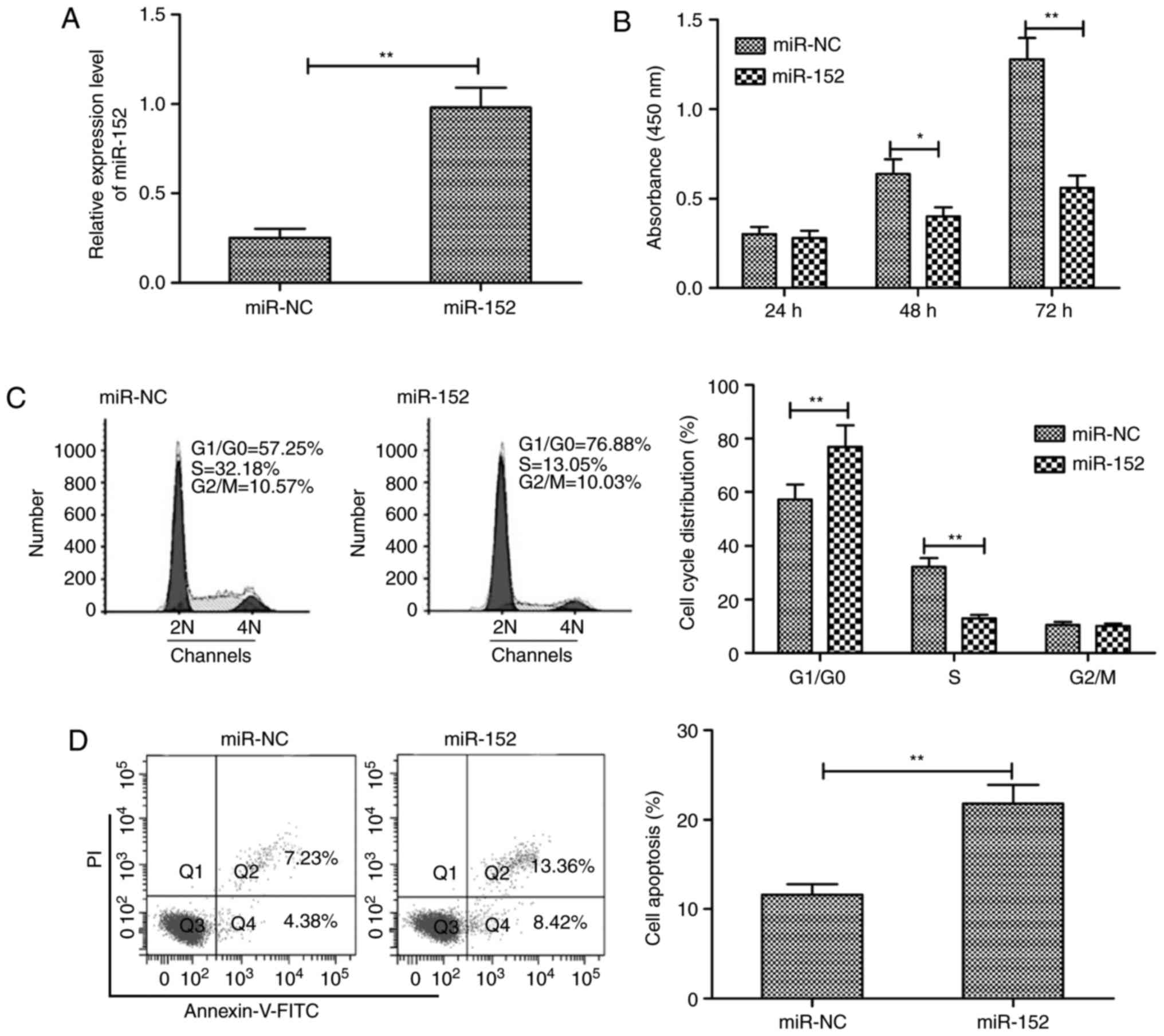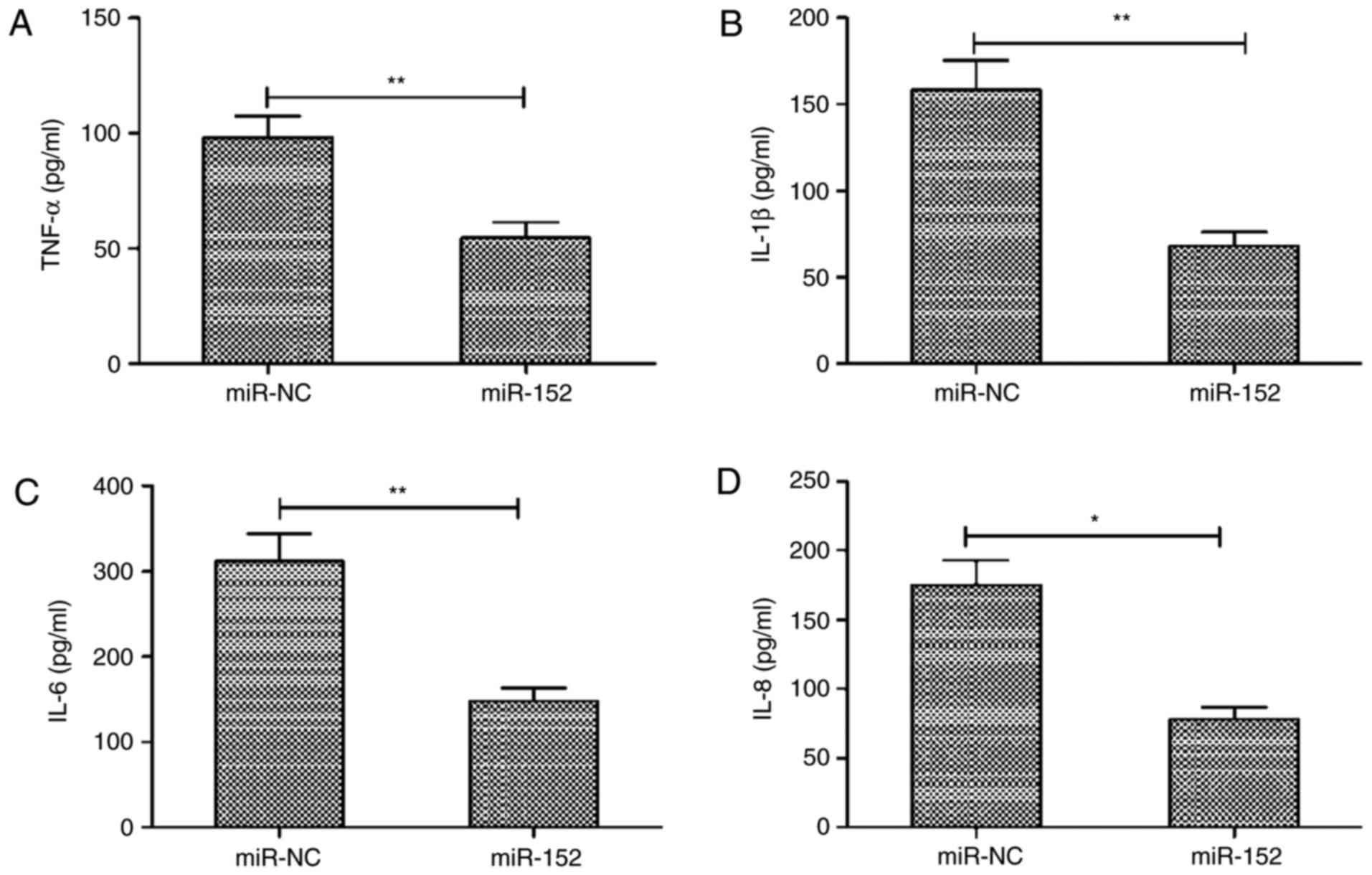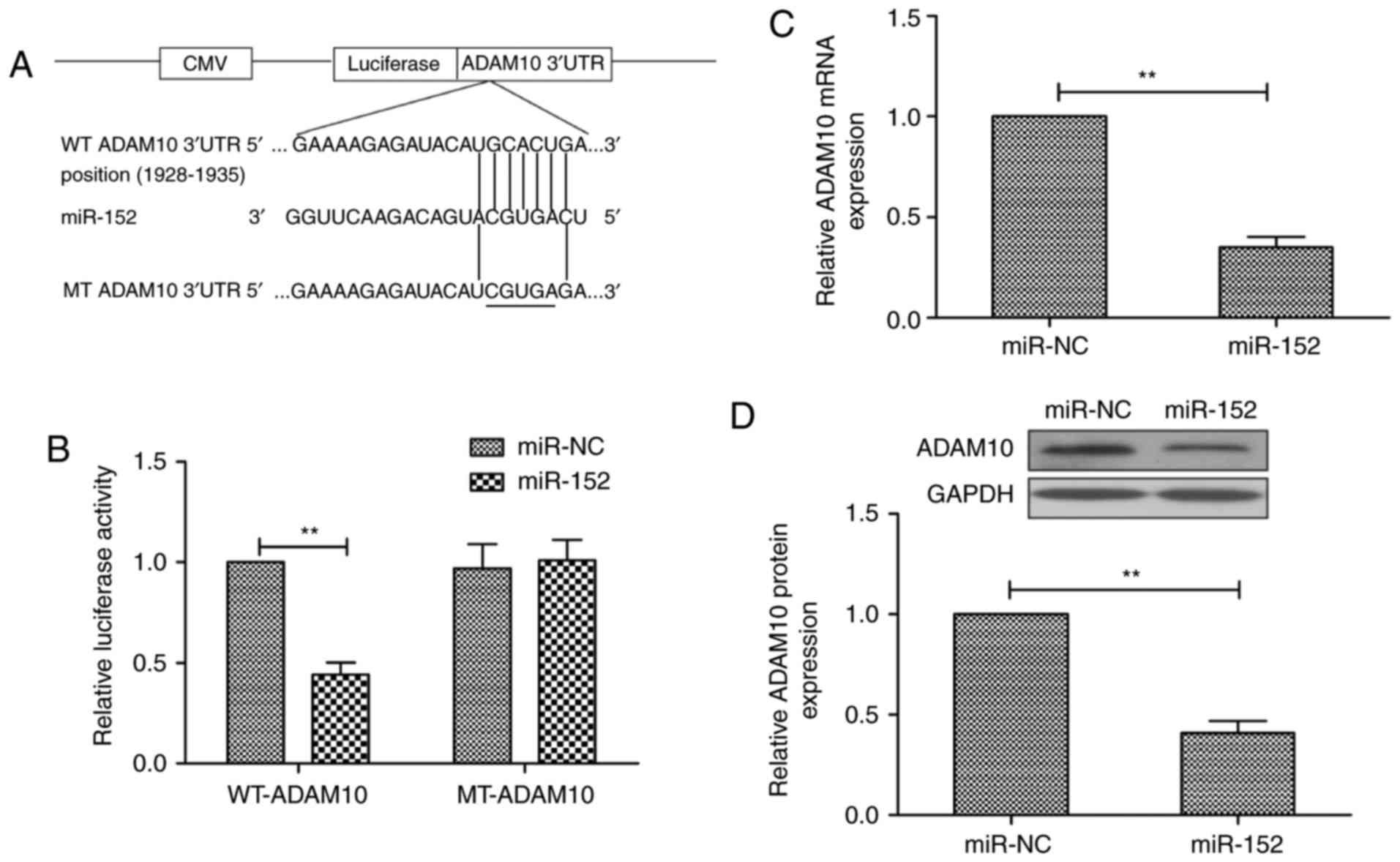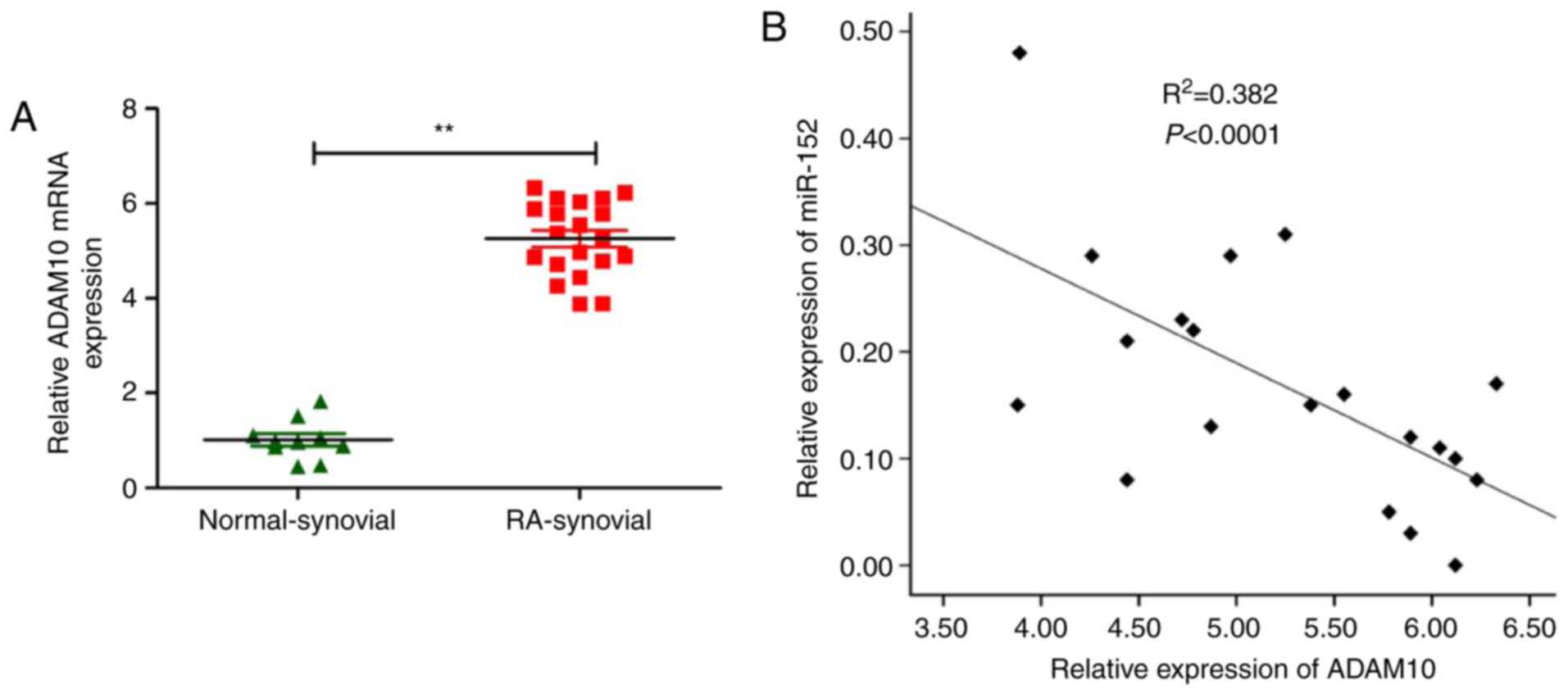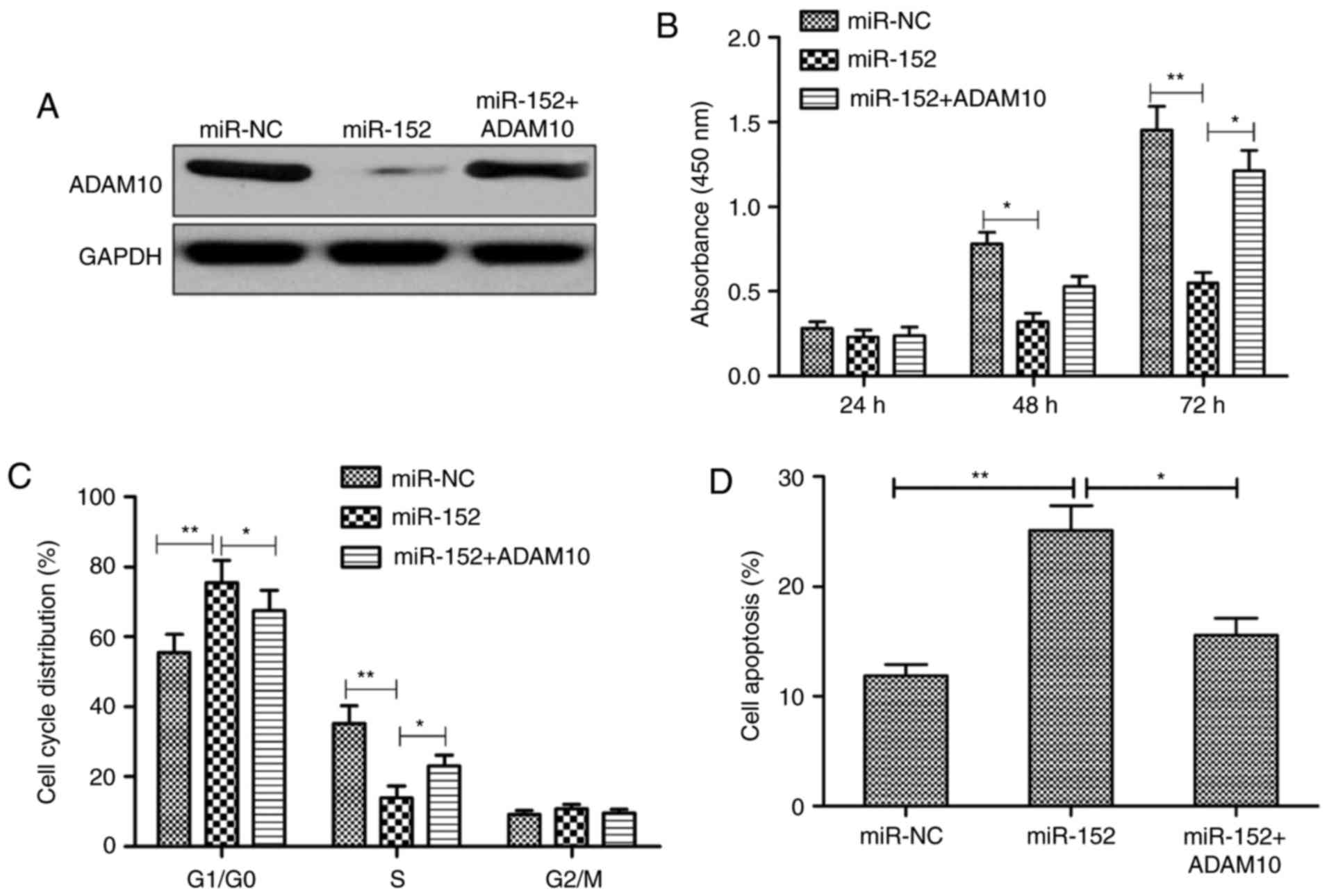miR‑152 inhibits rheumatoid arthritis synovial fibroblast proliferation and induces apoptosis by targeting ADAM10
Retraction in: /10.3892/ijmm.2021.5007
- Authors:
- Published online on: April 20, 2018 https://doi.org/10.3892/ijmm.2018.3636
- Pages: 643-650
Abstract
Introduction
Rheumatoid arthritis (RA) is a chronic autoimmune disease pathologically characterized by inflammatory cell infiltration, joint swelling, pannus formation, articular cartilage degradation and structural bone erosion, which leads to progressive disability and premature death (1). RA fibroblast-like synoviocytes (RA-FLS) have been reported to be involved in RA aggressiveness by producing abundant cytokines and matrix metalloproteinases (MMPs) (2). In addition, FLS proliferation causes the immune reaction and subsequently results in the impairment of joint tissue (3). In light of the key role of FLS in RA, it has become a hot topic of study to determine potential elements that can regulate FLS activity.
MicroRNAs (miRNAs) are small (18-25 nucleotides in length), single stranded, non-coding RNAs that can regulate gene expression by sequence-specific binding to the 3′-untranslated regions (3′UTR) of target mRNAs, leading to mRNA destruction or translational inhibition (4,5). It has been increasingly evident that miRNAs serve crucial roles in various biological functions, including proliferation, invasion, apoptosis and differentiation (6,7). Abnormal miRNA expression has been reported to be involved in the occurrence and development of RA, suggesting that miRNAs might serve as diagnosis markers or therapy targets for this disease (8,9).
miR-152 has been widely studied as a tumor suppressor by inhibiting tumor growth (10–15). A recent study has demonstrated that miR-152 inhibits the production of cytokines, including interleukin (IL)-12, IL-6 and tumor necrosis factor (TNF)-α (16). In addition, miR-152 inhibits the interferon-β-mediated upregulation of major histocompatibility complex class II and the dendritic cell-initiated antigen-specific T cell proliferation by targeting Calcium/calmodulin-dependent protein kinase type II α chain (CaMKIIα) (16), suggesting that miR-152 is involved in regulating the immune response. As far as RA is concerned, miR-152 has been demonstrated to be downregulated in an arthritic rat model (17,18), and to decrease FLS proliferation by inhibiting Wnt pathway activation (18). However, the functional significance and molecular mechanisms underlying the role of miR-152 in human RA remain largely unknown. The aim of the present study was therefore to explore the functional role and the underlying mechanism of miR-152 in RA.
Materials and methods
Tissue specimen collection and FLS culture
Serum and synovial tissue samples from 20 patients with RA (14 women and 6 men; 35-72 years old; mean age, 52) were obtained during joint surgery at the China-Japan Union Hospital of Jilin University (Changchun, China) from July 2015 to July 2016. Specimens from ten healthy donors (6 men and 4 women; age range, 34-69 years old; mean age, 51) were obtained from patients with joint trauma undergoing joint replacement surgery at the China-Japan Union Hospital of Jilin University. Healthy control specimens were selected by excluding for other diseases, such as autoimmune diseases, infectious diseases and cancer. All participants gave informed consent and agreed to participate in the study. This study was approved by the Research Ethics Committee of Jilin University (Changchun, China).
FLS were prepared from the synovial tissues of three healthy donors or three patients with RA, as described previously (18), and termed normal-FLS and RA-FLS respectively. FLS were cultured in Dulbecco’s modified Eagle’s medium (DMEM; Gibco; Thermo Fisher Scientific, Inc., Waltham, MA, USA) containing 10% fetal bovine serum (FBS; Gibco; Thermo Fisher Scientific, Inc.) and 1% penicillin/streptomycin, and maintained under 37°C with 5% CO2 and 95% air.
Cell transfection
miR-152 mimic (5′-UCAGUGCAUGACAGAACUUGG-3′) or corresponding negative control mimic miR-NC (5′-GUCCTUGCUCGAGCGAGGUGA-3′) were purchased from RiboBio Co., Ltd (Guangzhou, China), and were transiently transfected into RA-FLS at a final concentration of 100 nM for 24-72 h using Lipofectamine® 2000 (Thermo Fisher Scientific, Inc.), according to the manufacturer’s instructions. The vector overexpressing a disintegrin and metalloproteinase domain-containing protein 10 (ADAM10) (pCDNA3.1-ADAM10) was granted from Yahui Liu (Jilin University, Changchun, China), and was transfected into RA-FLS at a final concentration of 100 ng using Lipofectamine 2000 (Thermo Fisher Scientific, Inc.).
RNA isolation and reverse transcription-quantitative polymerase chain reaction (RT-qPCR)
Total RNA was isolated from serum, synovial tissues and cultured FLS using TRIzol (Thermo Fisher Scientific, Inc.) according to the manufacturer’s protocol. The corresponding cDNA was synthesized using M-MLV First Strand kit (Taraka Biotechnology Co., Ltd., Dalian, China) following the manufacturer’s instructions. qPCR was performed using Real-time PCR Mixture Reagent (Takara Biotechnology Co., Ltd.) and an ABI 7900 quantitative PCR instrument (Applied Biosystems; Thermo Fisher Scientific, Inc.) to detect the relative expression levels of miR-152 and ADAM10 mRNA. The primers for miR-152 and U6 were purchased from Applied Biosystems (Thermo Fisher Scientific, Inc.) Primers for miR-152 and U6 used were as follows: MiR-152 sense, 5′-TCAGTGCATGACAGAACTTGGAA-3′ and antisense, 5′-GCTGTCAACGATACGCTACGT-3′; U6 sense, 5′-TGCGGGTGCTCGCTTCGGCAGC-3′ and anti-sense, 5′-CCAGTGCAGGGTCCGAGGT-3′. The following thermocycling conditions were used: Denaturation at 94°C for 3 min, followed by 40 cycles of amplification (denaturation at 94°C for 15 sec, annealing at 60°C for 30 sec and extension at 72°C for 40 sec). The primers for ADAM10 and GAPDH were used as described previously (19). U6 and GAPDH were used as endogenous controls for the detection of miR-152 and ADAM10, respectively. The relative expression levels of miR-152 and ADAM10 mRNA were calculated using the 2−ΔΔCq method (20).
Cell proliferation assay
Cell proliferation was evaluated using a Cell Counting Kit-8 assay (CCK-8; Dojindo Molecular Technologies, Inc., Kumamoto, Japan). Briefly, following transfection for 24 h, RA-FLS cultured in DMEM medium containing 10% FBS were seeded into 96-well plates at a density of 5×103 cells/well for 24-72 h. Subsequently they were treated with 20 μl CCK-8 solution for 4 h. Absorbance was detected at 450 nm using a microplate reader (SpectraMAX Plus; Molecular Devices, LLC, Sunnyvale, CA, USA).
Cell cycle assay
RA-FLS were harvested at 48 h post-transfection and fixed in 75% iced ethyl alcohol overnight at 4°C. Subsequently, RNaseA was added and the cells were placed in a water bath in the dark for 30 min. Then RA-FLS were resuspended in 500 μl of binding buffer containing 5 μl of propidium iodide (PI; Sigma-Aldrich; Merck KGaA, Darmstadt, Germany). The proportions of cells in the G1/G0, S, and G2/M phases were determined using a FACSCalibur flow cytometer (BD Biosciences, San Jose, CA, USA) and CellQuest software 3.2 (BD Biosciences).
Cell apoptosis assay
Cell apoptosis was determined using an Annexin V-FITC Apoptosis Detection kit (KeyGEN Biotech Co., Ltd., Nanjing, China) according to the manufacturer’s protocol, using a FACS-Calibur flow cytometer (BD Biosciences). The data was analyzed with CellQuest software 3.2 (BD Biosciences).
ELISA
At 48 h post-transfection, RA-FLS were harvested by centrifugation at 3,000 × g for 10 min at 4°C. TNF-α, IL-1β, IL-6 and IL-8 levels in the supernatant were measured using TNF-α, IL-1β, IL-6 and IL-8 ELISA kits (cat nos. 550612, 557996, 550799 and 5507999, respectively; BD Biosciences) according to the manufacturer’s protocol. The optical density (OD) value at 450 nm was measured using Titertek Multiscan MCC 340 (Thermo Labsystems, Helsinki, Finland).
miRNA target prediction and luciferase reporter assay
TargetScan7.1, PicTar and miRDB were used to predict the putative targets of miR-152 (21–23). The ADAM10 3′UTR target site for miR-152 was synthesized and inserted into the pmirGlo luciferase vector (Promega Corporation, Madison, WI, USA), and was designated as WT-ADAM10-3′UTR. Site-directed mutagenesis of the miR-152 target site in the ADAM10-3′UTR was performed using the QuickChange mutagenesis kit (Stratagene; Agilent Technologies GmbH, Waldbronn, Germany). The mutant vector was designated as MT-ADAM10-3′UTR. For the luciferase reporter assay, RA-FLS were co-transfected with miR-152 mimic or miR-NC, and WT-ADAM10-3′UTR or MT-ADAM10-3′UTR reporter plasmid using Lipofectamine 2000 (Thermo Fisher Scientific, Inc.). At 48 h post-transfection, the Dual-Luciferase Reporter Assay kit (Promega Corporation) was used to assess the relative luciferase activity in the RA-FLS. Renilla luciferaseacitivity was used for normalization.
Western blot analysis
Cytoplasmic and nuclear proteins were extracted from cultured RA-FLS following the instructions of the RIPA buffer kits (Beyotime Institute of Biotechnology, Jiangsu, China). The protein concentrations were quantified using a bicinchoninic acid assay kit (Pierce; Thermo Fisher Scientific, Inc.). A total of 30 μg protein per sample was separated by 10% SDS-PAGE, followed by wet-transfer to polyvinylidene fluoride membranes (Millipore; Merck KGaA). Subsequently, the membrane was blocked for 2 h using 5% skim milk, and incubated with the following antibodies overnight at 4°C: anti-ADAM10 (1:1,000; Santa Cruz Biotechnology, Inc., Dallas, TX, USA), and anti-GAPDH (1:3,000; cat no. sc-365062; Santa Cruz Biotechnology, Inc.). Thereafter, the membrane was incubated with horseradish peroxidase-conjugated secondary antibodies (1:5,000; cat no. sc-2005; Santa Cruz Biotechnology, Inc.) at room temperature for 2 h. Protein bands were visualized using enhanced chemiluminescence (ECL; WesternBright ECL kit; Advansta, Inc., Menlo Park, CA, USA) according to the manufacturer’s instructions. Relative protein expression was evaluated using ImageJ software (National Institutes of Health, Bethesda, MD, USA).
Statistical analysis
All statistical analyses were performed using SPSS version 19.0 (IBM Corp., Armonk, NY, USA). Results are expressed as the mean ± standard deviation from ≥3 independent experiments. Differences between two groups were analyzed with the Mann-Whitney test and among three groups with one-way analysis of variance with Tukey’s post hoc test. Spearman’s correlation analysis was performed to examine correlation. P<0.05 was considered to indicate a statistically significant difference.
Results
miR-152 is downregulated in serum, synovial tissues and FLS from patients with RA
To investigate miR-152 expression in serum, synovial tissues and FLS from patients with RA, RT-qPCR was performed. The results revealed that the expression levels of miR-152 in serum, synovial tissues and FLS from patients with RA were decreased compared with the corresponding samples from healthy donors (P<0.05; Fig. 1). These findings suggest that downregulation of miR-152 may be involved in progression of human RA.
miR-152 inhibits cell proliferation and induces apoptosis in RA-FLS
To assess the biological effects of miR-152 in RA-FLS, miR-152 mimic and miR-NC were transiently transfected into RA-FLS and then cell proliferation, cell cycle phase distribution and apoptosis were examined. RT-qPCR analysis confirmed that miR-152 expression was significantly increased in RA-FLS transfected with miR-152 mimic compared with RA-FLS transfected with miR-NC (Fig. 2A). The CCK-8 assay was performed to investigate the effect of miR-152 overexpression in RA-FLS proliferation, and the results demonstrated that restoration of miR-152 expression significantly inhibited RA-FLS proliferation (Fig. 2B). In addition, the effect of miR-152 overexpression on cell cycle phase distribution was investigated in RA-FLS, and the results revealed that overexpression of miR-152 in RA-FLS significantly increased the proportion of cells arrested in the G0/G1 phase, while reducing the proportion of cells in the S phase (Fig. 2C). Cell apoptosis assays demonstrated that restoration of miR-152 expression significantly increased the apoptosis rate of RA-FLSs compared with miR-NC transfection (Fig. 2D).
miR-152 inhibits the expression of pro-inflammatory cytokines in RA-FLS
Next, the effects of miR-152 abnormal expression on the production of pro-inflammatory cytokines were evaluated. The expression levels of TNF-α, IL-1β, IL-6 and IL-8 were assayed in RA-FLS transfected with miR-152 mimic or miR-NC by ELISA. The results demonstrated that overexpression of miR-152 in RA-FLS significantly inhibited the production of TNF-α, IL-1β, IL-6 and IL-8 (Fig. 3A-D).
ADAM10 is a target of miR-152 in RA-FLS
To explore the underlying mechanism in RA-FLS progression, three publicly available miRNA-target prediction tools were used (TargetScan7.1, PicTar and miRDB) in order to discover potential gene targets for miR-152. As illustrated in Fig. 4A, ADAM10 was predicted as a potential target gene for miR-152, with a binding position at 1928-1935 bp. To confirm that ADAM10 is a direct target of miR-152, a luciferase reporter assay was conducted in RA-FLS at 48 h following co-transfection of vectors containing wild-type (WT) or mutant (MT) ADAM10 3′UTR sequences, and miR-152 mimic or miR-NC. The results demonstrated that overexpression of miR-152 significantly suppressed the luciferase activity of the reporter WT-ADAM10-3′UTR construct, but not of the mutant ADAM10-3′UTR construct, in RA-FLS (Fig. 4B). In addition, overexpression of miR-152 significantly suppressed ADAM10 expression, both at the mRNA (Fig. 4C) and the protein level (Fig. 4D). These results suggest that ADAM10 is a direct target of miR-152 in RA-FLS.
ADAM10 is upregulated in RA-FLS and inversely correlated with miR-152
Next, the potential correlation between expression of miR-152 and ADAM10 in synovial tissues from RA patients was investigated. ADAM10 mRNA expression levels were examined in synovial tissues from patients or from healthy donors using RT-qPCR. The results demonstrated that ADAM10 mRNA levels were higher in the synovial tissues from patients with compared with specimens from healthy donors (P<0.05; Fig. 5A). Additionally, ADAM10 transcript levels were also revealed to be inversely correlated with miR-152 expression levels in synovial tissues from RA patients by Spearman’s rank test (r=−0.681; P<0.001; Fig. 5B).
ADAM10 mediates the functional effects of miR-152 on RA-FLS
To determine whether the biological role of miR-152 is mediated by repressing the expression of ADAM10, RA-FLS were co-transfected with miR-152 mimic and an ADAM10-overexpressing plasmid that lacks the 3′UTR. The results demonstrated that miR-152-mediated ADAM10 downregulation was restored following co-transfection with miR-152 mimic and ADAM10 plasmid (Fig. 6A). Additionally, the effects of miR-152 on proliferation, cell cycle arrest, and apoptosis were reversed following overexpression of ADAM10 in RA-FLS (Fig. 6B-D). Collectively, these data suggest that miR-152 exerts a suppressive role in RA-FLS by targeting ADAM10.
Discussion
RA-FLS, located in the intimal lining of the synovium, have been reported to have a crucial role in RA, through producing cytokines that perpetuate inflammation and proteases that contribute to cartilage destruction (24). In addition, RA-FLS are implicated in the bone-eroding pannus formation and advanced angiogenesis of the joint (25). Direct targeting of RA-FLS is considered as a novel method to ameliorate the course of the disease. A growing body of evidence has revealed that miRNAs are involved in RA initiation and development by regulating RA-FLS progression (26). For example, Qu et al (27) reported that miR-126 targeting phosphoinositol-3 kinase regulatory subunit 2 significantly promotes growth and resistance apoptosis of RA-FLS by regulating the PI3K/AKT signaling pathway. Zhang et al (28) reported that overexpression of miR-125b promotes inflammation in RA-FLS by activation of the nuclear factor (NF)-κB pathway. Yang and Yang (29) demonstrated that downregulation of miR-221 significantly suppressed the expression of pro-inflammatory cytokines and chemokines, and inhibited FLS migration and invasion via inhibiting vascular endothelial growth factor, MMP3 and MMP9 expression. In the present study, the results demonstrated that miR-152 was downregulated in serum, synovial tissues and FLS from patients with RA compared with healthy controls, which is consistent with a previous report that miR-152 expression was decreased in FLS from an arthritic rat model (18). The present results also demonstrated that overexpression of miR-152 suppressed RA-FLS proliferation, promoted apoptosis, and decreased the production of TNF-α, IL-1β, IL-6 and IL-8. Finally, the present study identified and confirmed that ADAM10 was a direct and functional target of miR-152 in RA-FLS.
miR-152, a member of the miR-148/152 family, has been reported to be involved in a series of cell activities, including cell proliferation, apoptosis, cell cycle arrest, invasion and angiogenesis (10–18). Accumulating evidence has suggested that miR-152 has crucial roles in autoimmune disorders, chronic inflammatory diseases and multiple types of cancer (30,31). miR-152 has been reported to be downregulated in an arthritic rat model, and to decrease FLS proliferation by inhibiting Wnt pathway activation (17,18). However, the functional significance and molecular mechanisms underlying the role of miR-152 in RA remained largely unknown. In the present study, RT-qPCR qas used to determine miR-152 expression in humans, and the results revealed that miR-152 was frequently downregulated in serum, synovial tissues and FLS from patients with RA compared with healthy controls. The results also demonstrated that miR-152 could inhibit RA-FLS progression by inhibiting cell proliferation, promoting cell apoptosis, and reducing cytokine production.
In order to identify the mechanisms by which miR-152 regulates RA-FLS, three publicly available miRNA-target prediction tools (TargetScan7.1, PicTar and miRDB) were used to discover potential targets of miR-152. ADAM10 was predicted as a potential target gene of miR-152. ADAM10, a member of the ADAM family, has been reported to be involved in initiation and development of multiple diseases (32). In RA, it has been reported that ADAM10 was overexpressed in RA synovial tissue and was critical in RA angiogenesis (33). In addition, ADAM10 silencing has been reported to suppress the expression of TNF-α, IL-6, IL-8 and chemokine (C-X-C motif) ligand 16 in human RA-FLS, and to inhibit RA-FLS proliferation, migration and invasion, as well as to reduce the arthritis score in collagen-induced arthritis mice (34). In the present study, it was confirmed that ADAM10 was a direct target of miR-152 in RA-FLS by luciferase reporter assay, RT-qPCR and western blot analysis. The increased expression of ADAM10 mRNA was also examined in synovial tissues from patients with RA by RT-qPCR. The results confirmed that miR-152 expression levels in the RA synovial tissues were negatively associated with the expression of ADAM10 mRNA by Spearman’s correction. Additionally, further experiments indicated that the effects of miR-152 on proliferation, cell cycle arrest, and apoptosis were reversed following ADAM10 overexpression in RA-FLS. All the above results suggested that miR-152 suppressed proliferation, promoted apoptosis, and decreased cytokine production in RA-FLS, at least in part, by repressing ADAM10.
Due to the limited number of RA patients in the present study, further studies will be necessary to fully explore the potential role of miR-152 in RA progression. However, the present results provide evidence that miR-152 expression is downregulated in serum, synovial tissues and FLS from patients with RA. In addition, the present results indicated that miR-152 inhibited cell proliferation, induced cell apoptosis, and reduced cytokine production in RA-FLS by targeting ADAM10. These findings suggest that miR-152 might serve as a promising new therapeutic target for RA.
Acknowledgments
Not applicable.
References
|
Firestein GS: Evolving concepts of rheumatoid arthritis. Nature. 423:356–361. 2003. View Article : Google Scholar : PubMed/NCBI | |
|
Raptopoulou A, Sidiropoulos P, Katsouraki M and Boumpas DT: Anti-citrulline antibodies in the diagnosis and prognosis of rheumatoid arthritis: Evolving concepts. Crit Rev Clin Lab Sci. 44:339–363. 2007. View Article : Google Scholar : PubMed/NCBI | |
|
Miossec P: Rheumatoid arthritis: Still a chronic disease. Lancet. 381:884–886. 2013. View Article : Google Scholar : PubMed/NCBI | |
|
Bushati N and Cohen SM: microRNA functions. Ann Rev Cell Dev Biol. 23:175–205. 2007. View Article : Google Scholar | |
|
Hwang HW and Mendell JT: MicroRNAs in cell proliferation, cell death, and tumorigenesis. Br J Cancer. 94:776–780. 2006. View Article : Google Scholar : PubMed/NCBI | |
|
Volinia S, Calin GA, Liu CG, Ambs S, Cimmino A, Petrocca F, Visone R, Iorio M, Roldo C, Ferracin M, et al: A microRNA expression signature of human solid tumors defines cancer gene targets. Proc Natl Acad Sci USA. 103:2257–2261. 2006. View Article : Google Scholar : PubMed/NCBI | |
|
de la Chapelle A and Jazdzewski K: MicroRNAs in thyroid cancer. J Clin Endocrinol Metab. 96:3326–3336. 2011. View Article : Google Scholar : PubMed/NCBI | |
|
O’Connell RM, Rao DS and Baltimore D: microRNA regulation of inflammatory responses. Ann Rev Immunol. 30:295–312. 2012. View Article : Google Scholar | |
|
Stanczyk J, Pedrioli DM, Brentano F, Sanchez-Pernaute O, Kolling C, Gay RE, Detmar M, Gay S and Kyburz D: Altered expression of MicroRNA in synovial fibroblasts and synovial tissue in rheumatoid arthritis. Arthritis Rheum. 58:1001–1009. 2008. View Article : Google Scholar : PubMed/NCBI | |
|
Liu X, Li J, Qin F and Dai S: miR-152 as a tumor suppressor microRNA: Target recognition and regulation in cancer. Oncol Lett. 11:3911–3916. 2016. View Article : Google Scholar : PubMed/NCBI | |
|
Zhang YJ, Liu XC, Du J and Zhang YJ: MiR-152 regulates metastases of non-small cell lung cancer cells by targeting neuropilin-1. Int J Clin Exp Pathol. 8:14235–14240. 2015. | |
|
Li B, Xie Z and Li B: miR-152 functions as a tumor suppressor in colorectal cancer by targeting PIK3R3. Tumour Biol. 37:10075–10084. 2016. View Article : Google Scholar : PubMed/NCBI | |
|
Tang XL, Lin L, Song LN and Tang XH: Hypoxia-inducible miR-152 suppresses the expression of WNT1 and ERBB3, and inhibits the proliferation of cervical cancer cells. Exp Biol Med (Maywood). 241:1429–1437. 2016. View Article : Google Scholar | |
|
Ma J, Yao Y, Wang P, Liu Y, Zhao L, Li Z, Li Z and Xue Y: MiR-152 functions as a tumor suppressor in glioblastoma stem cells by targeting Krüppel-like factor 4. Cancer Lett. 355:85–95. 2014. View Article : Google Scholar : PubMed/NCBI | |
|
Zheng X, Chopp M, Lu Y, Buller B and Jiang F: MiR-15b and miR-152 reduce glioma cell invasion and angiogenesis via NRP-2 and MMP-3. Cancer Lett. 329:146–154. 2013. View Article : Google Scholar : | |
|
Liu X, Zhan Z, Xu L, Ma F, Li D, Guo Z, Li N and Cao X: MicroRNA-148/152 impair innate response and antigen presentation of TLR-triggered dendritic cells by targeting CaMKIIα. J Immunol. 185:7244–7251. 2010. View Article : Google Scholar : PubMed/NCBI | |
|
Miao CG, Qin D, Du CL, Ye H, Shi WJ, Xiong YY, Zhang XL, Yu H, Dou JF, Ma ST, et al: DNMT1 activates the canonical Wnt signaling in rheumatoid arthritis model rats via a crucial functional crosstalk between miR-152 and the DNMT1, MeCP2. Int Immunopharmacol. 28:344–353. 2015. View Article : Google Scholar : PubMed/NCBI | |
|
Miao CG, Yang YY, He X, Huang C, Huang Y, Qin D, Du CL and Li J: MicroRNA-152 modulates the canonical Wnt pathway activation by targeting DNA methyltransferase 1 in arthritic rat model. Biochimie. 106:149–156. 2014. View Article : Google Scholar : PubMed/NCBI | |
|
Liu S, Zhang W, Liu K, Ji B and Wang G: Silencing ADAM10 inhibits the in vitro and in vivo growth of hepatocellular carcinoma cancer cells. Mol Med Rep. 11:597–602. 2015. View Article : Google Scholar | |
|
Livak KJ and Schmittgen TD: Analysis of relative gene expression data using real-time quantitative PCR and the 2(-Delta Delta C(T)) method. Methods. 25:402–408. 2001. View Article : Google Scholar | |
|
Agarwal V, Bell GW, Nam JW and Bartel DP: Predicting effective microRNA target sites in mammalian mRNAs. eLife. 4:2015. View Article : Google Scholar | |
|
Krek A, Grün D, Poy MN, Wolf R, Rosenberg L, Epstein EJ, MacMenamin P, da Piedade I, Gunsalus KC, Stoffel M and Rajewsky N: Combinatorial microRNA target predictions. Nat Genet. 37:495–500. 2005. View Article : Google Scholar : PubMed/NCBI | |
|
Wong N and Wang X: miRDB: An online resource for microRNA target prediction and functional annotations. Nucleic Acids Res. 43(Database Issue): D146–D152. 2015. View Article : Google Scholar : | |
|
Bartok B and Firestein GS: Fibroblast-like synoviocytes: Key effector cells in rheumatoid arthritis. Immunol Rev. 233:233–255. 2010. View Article : Google Scholar : PubMed/NCBI | |
|
Stanford SM, Maestre MF, Campbell AM, Bartok B, Kiosses WB, Boyle DL, Arnett HA, Mustelin T, Firestein GS and Bottini N: Protein tyrosine phosphatase expression profile of rheumatoid arthritis fibroblast-like synoviocytes: A novel role of SH2 domain-containing phosphatase 2 as a modulator of invasion and survival. Arthrit Rheum. 65:1171–1180. 2013. View Article : Google Scholar | |
|
Sujitha S and Rasool M: MicroRNAs and bioactive compounds on TLR/MAPK signaling in rheumatoid arthritis. Clin Chim Acta. 473:106–115. 2017. View Article : Google Scholar : PubMed/NCBI | |
|
Qu Y, Wu J, Deng JX, Zhang YP, Liang WY, Jiang ZL, Yu QH and Li J: MicroRNA-126 affects rheumatoid arthritis synovial fibroblast proliferation and apoptosis by targeting PIK3R2 and regulating PI3K-AKT signal pathway. Oncotarget. 7:74217–74226. 2016. View Article : Google Scholar : PubMed/NCBI | |
|
Zhang B, Wang LS and Zhou YH: Elevated microRNA-125b promotes inflammation in rheumatoid arthritis by activation of NF-κB pathway. Biomed Pharmacother. 93:1151–1157. 2017. View Article : Google Scholar : PubMed/NCBI | |
|
Yang S and Yang Y: Downregulation of microRNA221 decreases migration and invasion in fibroblastlike synoviocytes in rheumatoid arthritis. Mol Med Rep. 12:2395–2401. 2015. View Article : Google Scholar : PubMed/NCBI | |
|
Friedrich M, Pracht K, Mashreghi MF, Jäck HM, Radbruch A and Seliger B: The role of the miR-148/-152 family in physiology and disease. Eur J Immunol. 47:2026–2038. 2017. View Article : Google Scholar : PubMed/NCBI | |
|
Chen Y, Song YX and Wang ZN: The microRNA-148/152 family: Multi-faceted players. Mol Cancer. 12:432013. View Article : Google Scholar : PubMed/NCBI | |
|
Wetzel S, Seipold L and Saftig P: The metalloproteinase ADAM10: A useful therapeutic target? Biochim Biophys Acta. 1864:2071–2081. 2017. View Article : Google Scholar : PubMed/NCBI | |
|
Isozaki T, Ishii S, Nishimi S, Nishimi A, Oguro N, Seki S, Miura Y, Miwa Y, Oh K, Toyoshima Y, et al: A disintegrin and metalloprotease-10 is correlated with disease activity and mediates monocyte migration and adhesion in rheumatoid arthritis. Transl Res. 166:244–253. 2015. View Article : Google Scholar : PubMed/NCBI | |
|
Li D, Xiao Z, Wang G and Song X: Knockdown of ADAM10 inhibits migration and invasion of fibroblast-like synoviocytes in rheumatoid arthritis. Mol Med Rep. 12:5517–5523. 2015. View Article : Google Scholar : PubMed/NCBI |




